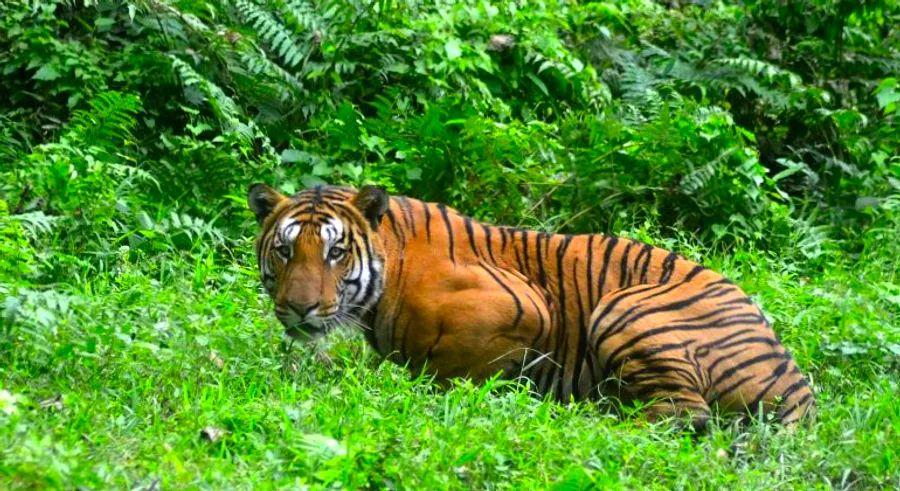Top locations to spot tigers in India

Looking to see a real wild tiger? India is home to nearly half of the world’s remaining wild tiger population, roaming freely across its vast landscapes.
With 1,400 big cats spread across more than 40 national parks, India offers plenty of opportunities for tiger sightings.
To increase your chances of spotting a tiger, we've narrowed down five locations where you’re most likely to get a good view of these majestic creatures in the wild.
1. Bandhavgarh National Park: The best place for tiger sightings

Bandhavgarh National Park, located in Madhya Pradesh, is a renowned wildlife sanctuary with the highest tiger density in the region. The park’s core area spans 100 square kilometers and is home to over 50 tigers.
Known as the land of the white tiger, Bandhavgarh once saw these rare creatures in the wild. The last wild white tiger was captured here in 1951 by Maharaja Martand Singh of Rewa.
The park is also home to a diverse range of animals including chital deer, sambar deer, barking deer, wild boar, nilgai antelope, four-horned antelope, Indian bison, wild dogs, leopards, blue bulls, Indian foxes, and bears.
Insider tip: Rent a car to explore Bandhavgarh Fort, which sits atop a 600-meter-high cliff with breathtaking views of the Vidhyan Mountains.
Best time to visit: The park is open from October to June, but for the best chances of spotting tigers, plan your visit between April and June.
As the weather heats up, wildlife tends to gather around the park's waterholes for a refreshing drink.
Closest airport: Jabalpur Airport is located 197 kilometers away, roughly a four-hour drive from the park.
Where to stay: Bandhav Vilas offers luxurious 93-square-meter villas, complete with a bedroom, private deck, and a courtyard with a rain shower.
Bandhav Vilas, Village Kuchwahi, Bandhavgarh, Madhya Pradesh
2. Ranthambore National Park: The ideal spot for capturing stunning tiger photographs

DITYA SINGH/AFP/GettyImages
If you've ever seen a famous tiger photo from India, it's most likely taken at Ranthambore National Park.
Covering 1,334 square kilometers, Ranthambore is one of India’s largest and most famous national parks, a hotspot for wildlife photographers.
Once a royal hunting ground for the Maharajas of Jaipur, Ranthambore rose to fame in the 1960s when Queen Elizabeth II visited and Prince Philip hunted a tiger here. In 1973, the park became a protected reserve for tigers, making it one of India's top tiger sanctuaries.
The park is known for its ancient ruins, including a historic fort where tigers and leopards are frequently sighted.
In addition to tigers, Ranthambore is home to a variety of wildlife, including leopards, jungle cats, sloth bears, hyenas, Indian foxes, jackals, and crocodiles.
Best time to visit: While the park is open from October to June, winter can be chilly, and summer heat can be overwhelming, making the cooler months the most comfortable time to explore.
The best time to spot tigers is between April and May, although February and March offer pleasant weather for a visit.
Insider tip: The park features three lakes—Padam Talao, Raj Talao, and Milak Talao—where animals are often seen gathering. For tiger sightings, head to the Bakaula area, known for its thick forests and small watering holes, where tigresses and their cubs are frequently spotted.
Closest airport: Jaipur is located 132 kilometers from the park, roughly a three-hour drive by car.
Where to stay: The Oberoi Vanyavilas, Ranthambore offers a luxury experience with 25 tents spread across eight hectares, complete with a spa and two resident elephants.
The Oberoi Vanyavilas Ranthambore, Ranthambore Road, Rajasthan
3. Kanha National Park: A real-life 'Jungle Book' experience
The stunning Kanha National Park is reminiscent of Rudyard Kipling’s 'The Jungle Book.' Its expansive meadows offer some of the best opportunities to spot wildlife, including tigers.
You can almost imagine Mowgli wandering through the tall grasses, always on the lookout for the dreaded Shere Khan.
Kanha is also home to the hard-ground barasingha, a rare and endangered species of deer found only in this park. Other frequently spotted animals include chital, gaur, langurs, jackals, wild pigs, black bucks, striped hyenas, leopards, mouse deer, porcupines, and pangolins.
Insider tip: For a more peaceful safari, book an early morning elephant ride at the less-crowded Mukki entrance.
Be clear that you're booking a safari experience and not a tiger show, where elephants are trained to trap tigers for tourists to get a better view.
Best time to visit: Although the park is open from October to June, the prime time for tiger sightings is from April to June, during the warmer months.
Closest airport: Jabalpur Airport is located 175 kilometers away, approximately a three-hour drive.
Where to stay: Banjaar Tola, a luxury Taj Safari lodge, features 18 spacious tented suites.
Banjaar Tola, Kanha National Park, Madhya Pradesh
4. Jim Corbett National Park: Ideal for sweeping views

The Jim Corbett National Park is one of India’s oldest wildlife reserves, originally established as Hailey National Park in 1936. In the 1950s, it was renamed in honor of the famous hunter-turned-conservationist, Jim Corbett.
Located at the foothills of the Himalayas, Corbett spans 500 square kilometers of diverse landscapes, from sal forests to wetlands. Besides tigers, you're also likely to see leopards, sloth bears, jungle cats, fishing cats, jackals, and various species of deer and mountain goats.
Known as 'Elephant Park' for its abundant wild elephants, Corbett offers prime wildlife sightings along the Ramganga River, a top location for elephant viewing.
Insider tip: Birani, located on the park's eastern edge, features expansive grasslands and waterholes that frequently draw tigers and their prey.
Corbett also boasts several watchtowers, like the one at Dhikala, where you can spend hours observing the rich variety of wildlife.
Best time to visit: While Corbett is accessible from October to June, the best period for tiger sightings is from March to June, though dust may sometimes impair visibility.
Closest airport: Patnagar Airport is located 50 kilometers away, about an hour's drive from the park.
Where to stay: Jim’s Jungle Retreat offers a variety of accommodations, including safari tents, jungle cottages, and lodges, all set within six hectares of lush surroundings.
Jim’s Jungle Retreat, Village & PO Dhela, Ramnagar, Uttarakhand
5. Satpura National Park: Ideal for adventure seekers
Satpura National Park is a hidden gem in India's national park scene. Established in 1981, it remains less crowded, with only 12 vehicles permitted at a time.
The park is a sanctuary for tigers, hyenas, leopards, gaur, sambar, chital, barking deer, chinkara, mouse deer, wild boars, wild dogs, bears, black bucks, foxes, porcupines, and flying squirrels.
Insider tip: Satpura is the only national park where walking safaris are allowed, giving you the unique opportunity to explore on foot with a guide, bypassing the usual jeep ride.
In the summer months, visit the Sonbhadra River to witness tigers as they cool off with a swim.
Best time to visit: The ideal months for a visit are from October to March, though the best wildlife sightings occur from April to May.
Nearest airport: Bhopal is located 135 kilometers away, about a three-hour drive.
Where to stay: Reni Pani Jungle Lodge offers a peaceful retreat with 12 luxurious villas and a spa to unwind after your safari adventures.
Reni Pani Jungle Lodge, located in Sohagpur, Hoshangabad, Madhya Pradesh

1

2

3

4

5
Evaluation :
5/5